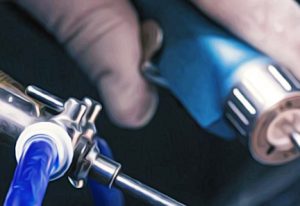
Arthroscopy procedures are often a favourable procedure technique for many surgeons as it is less invasive than open surgery and often means less scarring and a reduced recovery time for the patient. The first step in any arthroscopy procedure is to conduct an inspection of the affected joint or area. To do this, the surgeon will create two to three tiny incisions near the joint. It is through these holes that the surgeon will insert the arthroscope. An arthroscope is a thin fiber-optic tube with a camera and lens fixed on the end. This is fed through the incision and the camera will magnify images of the joint exterior and interior onto a screen monitor. After the area has been inspected, the tools for performing the surgery are inserted into the incisions. The camera will still need to be kept within the incision so the surgeon can view the area they are operating.
It is extremely important that the surgeon has a clear view when performing the arthroscopy. Steam layers over the lens are a frequent occurrence, particularly when performing a shoulder arthroscopy. This can be extremely frustrating for the surgeon as it makes the operating process difficult. There are multiple devices and techniques surgeons have applied to try to prevent steam, but unfortunately, it is not something that can be totally avoided. To remove the steam, surgeons often have to extract the arthroscopy and wipe the lens to continue the procedure. Innovators are trying endlessly to develop ways to minimise the occurrence of steam on the arthroscope.
When the surgeon is operating, a sterile solution is injected to expand the joint so there is extra room to work. When the surgery is complete, stitches are used to close the incision and dressing is applied. There are many surgeons specialising in elbow arthroscopy in the Melbourne area. It is often the preferred method to operate on a joint where it is an elbow, knee or shoulder, due to it having a smaller operating area than open surgery. The incisions are small and therefore scarring is minimised and patient recovery time is lessened.